And now, a rare look at the Second Ward’s indigenous Ship Channel dance ceremony, performed along the gentle banks of Buffalo Bayou and celebrating the bountiful fall harvest of crushed concrete.
- Tetsujin [Vimeo]
Video: Freneticore
And now, a rare look at the Second Ward’s indigenous Ship Channel dance ceremony, performed along the gentle banks of Buffalo Bayou and celebrating the bountiful fall harvest of crushed concrete.
Video: Freneticore
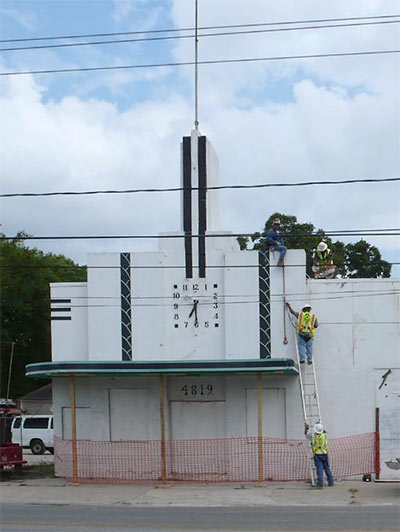
Eastwood clock-watcher Spencer Howard documents the end of the line for the 1935 Sterling Laundry & Cleaning Company building on Harrisburg. Metro doesn’t have any use for the bulk of the Streamline Moderne building in the way of the new light-rail East End Line. But how about grabbing that right-twice-a-day timepiece the building is wearing? The bulky fashion accessory might go with any of several new get-ups envisioned for Eastwood Park across the street.
METRO began the disassembly of the building last week. After several days of careful planning, joints were sawed into the steel frame, stucco clad facade. By the end of the week, a large crane was delivered to the site to assist with the removal of the facade.
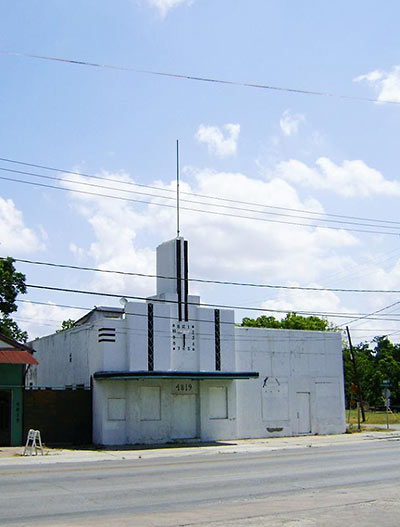
All that uproar over the impending demolition of a favorite Streamline Moderne structure in Eastwood seems to have had an effect: Houston architect Sol R. Slaughter’s 1935 Sterling Laundry & Cleaning Company building at 4819 Harrisburg will be preserved!
Sort of. Metro has committed to saving the façade.
Well . . . maybe at least the center part of it.
Okay really, just the top part, above the door. The part with the clock.
Hey, at least it’s not going to go away!
. . . ?
Uh, well . . . architectural antique fan Spencer Howard, who helped sound the alarm about Metro’s demolition plans for the building a few weeks ago, writes in with the latest:
Deconstruction will begin in two weeks, at which point the façade will be placed in storage (yet to be located) until the permanent home is designed (yet to be funded).
But the face-saving fun doesn’t stop there. After a short but brilliant week of investigations, brainstorming, and Photoshop work, Metro has produced a series of proposals for the rescued stretch of stucco that’s likely to be studied and appreciated by historic preservation experts, redevelopment advocates, and postmodern philosophers for some time to come.
Monday’s presentation at the offices of the Greater East End Management District was simply titled “4819 Harrisburg,” but that’s just Metro being modest. Maybe when this thing is resurrected for academic conferences it can be called something like “Representations of Time: Practical Opportunities in Deconstruction and Preservation.”
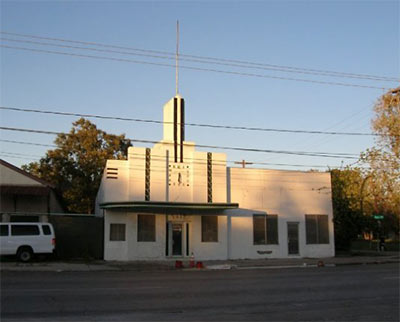
This timely building at 4819 Harrisburg in Eastwood, built in 1935 for the Sterling Laundry & Cleaning Co., showed up in yesterday’s Daily Demolition Report. The architect was Sol R. Slaughter, who also designed a home on the bayou in Idylwood the same year.
The building faces Metro’s new East End Corridor light-rail line. Rice University project manager Spencer Howard writes in with a few details, but isn’t exactly sure what’s going on:
The building was renovated as an artist live/work/gallery just a few years ago.
METRO pledged to save the facade of the building with the clock on it, across from Eastwood Park. They preferred to have someone else buy it and move it, but if that didn’t happen, they were going to move it back on the property and reattach it behind the new setback. Yesterday they sent out the demolition list for next Monday and it was on it. The neighborhood has alerted their gov’t reps.
Another view:
Here’s a whizzy reel showing what the new Metro trains and stations on 4 upcoming light-rail lines are supposed to look like. Dowling St. in the Third Ward, the Edloe Station in Greenway Plaza, the Moody Park Station on the North Line, MacGregor Park Station on the Southeast Line, and Lockwood Station on the East End Line each get about 30 seconds of CGI treatment, from a low-flying camera buzzing some extremely lifelike — though torpid — pedestrians.
Christof Spieler finds a few flaws:
The Third Ward footage seems to be out-of-date; it shows the old alignment crossing Dowling on Wheeler, not the new route that switches to Alabama. But other details are correct: the stations shown are the new prototype station design (by Rey de la Reza Architects), minus artwork.
It’s nice to be able to visualize what these lines might look like. But it’s also a reminder that it’s important to get the details right. At Edloe, for example, the trees integrated into the canopy are nice, but there’s no crosswalk at the west end of the station platform, which means a 500-foot detour for some riders. The Moody Park and MacGregor stations do show that crosswalk, and the sidewalks look pretty good, too. But in all the images, the overhead wires are suspended from their own poles in the middle of the street, not from the streetlight poles on either side, as on Main Street. That makes for more poles and a more cluttered streetscape.
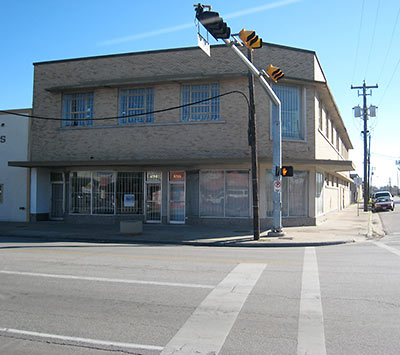
Tonight’s art opening at the new Box 13 ArtSpace will serve as a grand opening for the new East End art venue as well.
The space is a 2-story former furniture store on the corner of Harrisburg and Cesar Chavez (or — as the organization’s website uh, “artfully”(?) calls the street — “Cesar Chivas”). It features 13 studio spaces for artists in residence, three interior galleries, a storefront-window display space, and an “outdoor performance exhibition space,” known more conventionally as a parking lot.
The artist-run nonprofit intends to acquire a second building, at 6701 Capitol (directly behind the 6700 Harrisburg building), within a few months. “The Capitol building lends itself toward sculptors and installation artists,” declares the website.
After the jump: A quick tour of the new facilities!
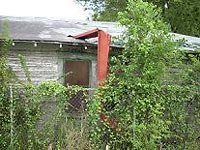 John Nova Lomax chronicles another pedestrian adventure with drummer pal David Beebe in Houstoned—this time through desolate pockets of Houston’s East Side. Their potion-and-perspiration-soaked journey begins at the southern end of the Fifth Ward.
John Nova Lomax chronicles another pedestrian adventure with drummer pal David Beebe in Houstoned—this time through desolate pockets of Houston’s East Side. Their potion-and-perspiration-soaked journey begins at the southern end of the Fifth Ward.
There, on the corner of Lyons Avenue and McKee, a dry-heaving stray dog in its death throes welcomed us to central Houston’s Chernobyl, a cursed warren of rusty train tracks, crumbling warehouses, and whole blocks that have reverted to wild coastal prairie.
Ruins of an entire neighborhood molder back here – unpainted shotgun shacks collapsing in on themselves scattered around a blocky brick building that looked like it was once a bar or liquor store. It had been stripped of all metal fixtures by street urchins and cut off from the electrical grid, but a sign in the window indicated it was for sale. “Call Bob,†it said. And evidently it was not so long ago a place of some importance, as a street teamer for a rapper named Marcelo had plastered a few promo posters on its door.
Next stop: Clinton Dr., where the “rank stench” of the 69th Street Wastewater Treatment Plant guides their path.
Lord have mercy on Clinton Drive. Save for a couple of islands of activity like the huge fenced-in KBR headquarters (which is rumored to be for sale), Clinton is now little more than a decrepit strip of ruined factories, warehouses fast crumbling into rubble, and decaying 1950s office buildings with broken windows and mold-stained walls.
It reminded me of 19th Century British gadfly William Cobbett’s description of the village of Deal, Sussex: “Deal is a most villainous place. It is full of filthy looking people. Great desolation of abomination has been going on here; tremendous barracks, partly pulled down and partly tumbling down and partly occupied by soldiers. Everything seems upon the perish. I was glad to hurry along through it…â€
It wasn’t always such. From the Ship Channel’s opening until the advent of containerized shipping in the early ‘80s, Clinton and surrounding streets were bustling by day and by night, dotted with rice beer-soaked bars with names like the Cesspool, the Worker’s Bar, the Seafarer’s Retreat, the Mermaid Café, Tater’s Last Chance and Dottie’s Snug Harbor.
In those days, it could take a week to unload a cargo ship, and for much of that time, sailors were free to roam the port, dine in the restaurants, carouse in the bars, and find companionship where they may. The same went for the thousands of shore-based workers – the mechanics, channel pilots, stevedores, and tug boat crews.
Neighborhood on the waterfront: Coulda been a contender.
Photo: David Beebe and John Nova Lomax
A whole lotta demo going on: A county outpost downtown, more industrial buildings along Studemont, plenty of houses, and more. Our daily list of addresses begins after the jump.
Nine houses and three buildings leave Houston. Our list of the newly departed begins after the jump.
Twenty doomed structures today. Say goodbye to them—after the jump.